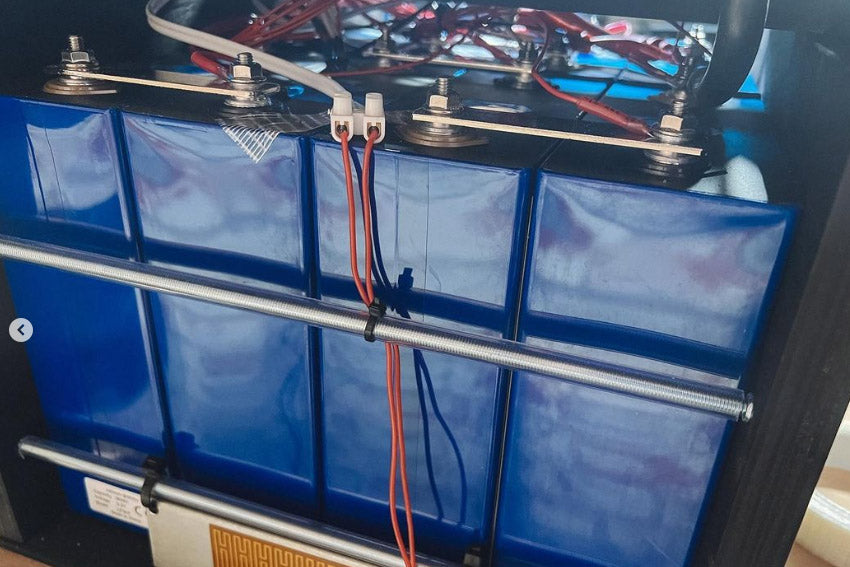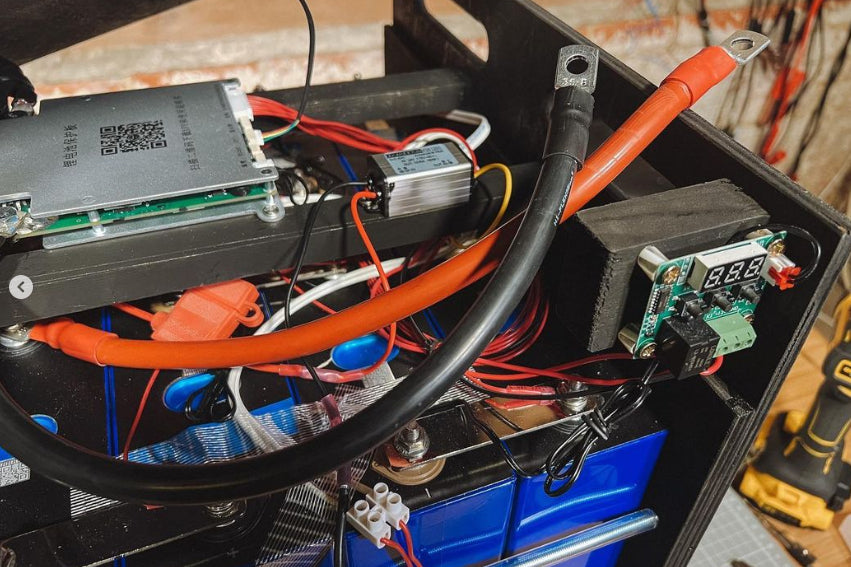Why Choose Diypow Lithium Batteries for Kayak?
Choosing Diypow lithium batteries as an energy source for kayaks is a wise choice for those who love to fish. Firstly, our LiFePO4 batteries offer excellent longevity and stability. You can rely on its long-lasting power during long fishing sessions without having to worry about running out of juice in the middle of the day. Whether you're chasing large fish or roaming the lake, the Diypow kayak battery provides you with a long-lasting and stable source of energy.
Secondly, weight and space considerations are very important as an energy option for kayaks. Our kayak batteries are only 1/3 the weight of lead acid batteries, have 10 times longer life, 4000 deep cycles, take up very little space and are easy to install. Reducing the weight of your boat allows you to catch lots of big fish faster.
In addition, the Diypow kayak trolling motor battery is reliably safe. It uses advanced protection mechanisms, including overcharge protection, over-discharge protection and short circuit protection, to ensure your safety and reliability during use. This allows you to focus on fishing without worrying about the safety of your battery.
So what are you waiting for? Come and get the best kayak batteries for you.
Diypow 12V 50AH Drop-In SLA Replacement Deep Cycle LiFePO4 Battery Pack
Diypow 12V 100AH Deep Cycle LiFePO4 Battery Pack | 1.28kWh & 1.28kW
Diypow 12V 120AH Drop-In SLA Replacement Deep Cycle LiFePO4 Battery Pack
Diypow 12V 200AH Deep Cycle LiFePO4 Battery Pack | 2.56kWh & 1.28kW
Diypow 24V 100AH Drop-In SLA Replacement Deep Cycle LiFePO4 Battery Pack
Diypow 36V 60AH Drop-In SLA Replacement Deep Cycle LiFePO4 Battery Pack
Diypow Best Fishing Kayak Batteries
Using a kayak makes our fishing easier. At the same time, kayaking is really a very fun sport. Even if you don't catch any fish, you can still paddle alone in the quiet water at dawn. It's enough to see the scenery.
Compared to shore fishing, kayak fishing is more convenient. In summer, fish hide in deep water and some are almost difficult to catch from the shore. But with a kayak and fish finder, you can find the structure on the bottom of the lake, making it easier to catch fish. Of course, by paddling directly to a small island or under a bridge pier in the lake, you don't have to worry about grabbing a spot with other people. Since the availability of lithium batteries, kayaking has become easier and more fun.
Using lithium kayak battery to power the motor, you can quickly drive the kayak to areas with dense fish populations. As long as you stay for a few minutes, you're sure to have a great time. But remember to bring GPS our 12v lithium kayak battery pack. Keeps you in touch with your family and lets them know you are safe.
More Application Scenarios
4 Types of Kayak Battery Technology
⚡LEAD-ACID BATTERIES
⚡AGM BATTERIES
⚡GEL BATTERIES
⚡LITHIUM BATTERIES
Diypow Lithium Kayak Batteries
⭐Consistent Output
⭐Long Lasting
⭐1/3 Lighter Than Lead Acid Battery
⭐6 Strong Protections
⭐Fast Charge
⭐Higher Discharge Rate
Best Selling Kayak Batteries
Diypow 12V 50AH Drop-In SLA Replacement Deep Cycle LiFePO4 Battery Pack
Diypow 12V 100AH Deep Cycle LiFePO4 Battery Pack | 1.28kWh & 1.28kW
Diypow 12V 120AH Drop-In SLA Replacement Deep Cycle LiFePO4 Battery Pack
Diypow 12V 200AH Deep Cycle LiFePO4 Battery Pack | 2.56kWh & 1.28kW
Latest from Our Blog
Kayak Fish Finder Battery Buying Guide
Want to upgrade your kayak now? Add a trolling motor and kayak trolling motor batteries. With kayak batteries, you can cover more water and catch more fish. A deep-cycle 12V marine battery will do the job.
But kayak trolling motor batteries can also power many useful electronic devices. Think fish finders, lights, GPS systems, and mobile phone chargers. Installing the right kayak trolling motor battery can help you enhance your kayaking and fishing adventures.
The best kayak battery is one that is large enough to power your motor and electronics, but small enough to keep your kayak light. So what is it? Lithium-ion batteries. Come and join us for a guide to buying kayak batteries.
1. What are Kayak batteries?
The kayak control motor is a lightweight, self-contained device that includes an electric motor, propeller and steering control. You mount the motor in the bow or stern of your kayak, connect it to the battery, and you instantly have a power boat. Hand- and foot-controlled models are available. Kayak fishing motors usually use a standard 12V marine battery. These small motors are easy to control, easy to install, and you won't break the bank for an upgrade.
2. What Is the Best Kayak Trolling Motor Battery? (Battery for Fish Finder Kayak)
When you compare lithium-ion batteries to lead-acid batteries, the answer is obvious: lithium-ion batteries are the best choice for kayak trolling motor batteries.
They last longer, weigh less, are safer for the environment, and are more efficient than lead-acid batteries. If you want to get your money's worth and want to keep your kayak trips worry-free, you'll want to choose a lithium-ion battery for your trolling motor.
We recommend our Diypow 12V 50AH kit. It has everything you need to power your trolling motor for a decade or more. Also, for long days out on the water, you can check out our 100Ah kayak kit to get you started.
3. How long will a 50Ah battery last on a trolling motor?
Typically a 50A battery can be deep cycled for 3000-5000 cycles. Capable of charging most of the accessories on your boat. Usually a day is no problem.
4. How long will the kayak battery last?
As we said, LiPo batteries are the best kayak batteries. Also known as the LiFePO4 kayak battery. reports show that the Diypow 100A battery can give an angler over 14 miles of travel.
5. Do you need a battery box for kayak?
A battery box for a kayak is not necessarily required, but it is strongly recommended for safety and convenience. A battery box helps protect the battery from water, impacts, and other hazards. It also keeps the battery securely in place, preventing it from shifting during movement. Additionally, a battery box can make it easier to connect and disconnect the battery when needed.
6. What kind of battery can I use to power the fish finder on my kayak?
If you are in a canoe or have a portable fish finder, it is still battery-powered. Typically, fish finders will use either a 12V lead acid or lithium battery. For many years, lead acid has been the standard battery, but more and more fish finders are using lithium batteries.
7. Should a fish finder be wired directly to the battery?
Connect the fish finder directly to the battery (starter battery or auxiliary battery). Do not take shortcuts and run the fishfinder power cord to a block or switch panel
8. How do I choose battery size?
Before shopping for batteries, you want to determine how much power you need. Desired energy storage capacity - - is usually measured using kilowatt-hours per day. Based on the power and runtime of all potential loads supported by the system, a minimum kWh per day value can be calculated.
9. When should I charge my fish finder battery?
12.0 volts or below - At 12.0 volts, your battery is considered fully discharged or "flat" and should be charged as soon as possible. If kept in this voltage range for an extended period of time, the life of the battery will be severely affected.
10. How to maintain a Kayak Battery?
To maintain the performance of your kayak battery, it is vital to recharge your kayak battery when the drip charge drops to 10-25%. Storage in a favorable environment is always a reliable option for battery maintenance. The premise is never to try to overcharge a battery.












